Samaaro + Your CRM: Zero Integration Fee for Annual Sign-Ups Until 30 June, 2025
- 00Days
- 00Hrs
- 00Min
Based on a survey, it has been found, “34% of event professionals plan to use the hybrid format for the majority of their events in 2023.” This demonstrates the increasing prominence of mixing in-person and virtual elements in the event sector. Organisers can reach beyond their physical restrictions through hybrid events. They can cater to a bigger audience by allowing people who are unable to attend in person due to distance, travel restrictions, or other factors to participate virtually. Sponsors also stand to gain significantly from hybrid events, as they obtain more exposure for their brand across two unique platforms, resulting in equal benefits on both fronts.
Having said that, effectively engaging attendees at hybrid events poses significant challenges. A hybrid event can provide distinct experiences to broad groups by incorporating both styles, but at the same time, it entails investing twice the effort in crafting distinct participant experiences, catering to both on-site and remote participants. Regardless of the event type, ensuring participants feel included requires active engagement with them. The above statistics show that hybrid events have grown in popularity in recent years, as they offer the best of both worlds. In this blog post, we’ll look at five trending features for hosting effective hybrid events that attract and engage your audience.

The introduction of photo booths in hybrid events expands the opportunity to create lasting memories that extends beyond just in-person attendees to virtual guests as well. Hybrid event platforms enable organizers to create a visually appealing photo booth area at the physical event location, complete with artwork, backdrops, and professional lighting, catering to the in-person audience.
Simultaneously, an online photo booth can also be enabled that allows virtual guests to click and post their own photos with a variety of backgrounds, frames & filters. Moving forward, an attractive photo gallery can be created to display all the pictures posted by both in-person and virtual attendees. This will help build a delightful sense of community where attendees can have access to like and comment on pictures posted by everyone.
This feature encourages conversation, networking, and a sense of support among players, regardless of whether they are present on-site or joining electronically. Attendees get the opportunity to make relationships through face-to-face interactions and mutual recognition.
Incorporate a virtual treasure hunt into your hybrid event to provide an intriguing and challenging experience. Use a dedicated event app or web-based platform that allows participants to participate in riddles, find clues, navigate spaces, and earn rewards.
This interactive activity fosters a sense of competitiveness and camaraderie among participants by encouraging exploration, teamwork, and the development of problem-solving skills. It not only allows participants to have fun during the event, but it also helps them collect prizes and achieve recognition on the leaderboard as they successfully navigate the treasure hunt.

In B2B conferences and workshops, a leaderboard for attendees would be highly valuable, allowing organizers to identify their most engaged attendees, customers, or new prospects. Gamification is a powerful tool for driving engagement, and an activity leaderboard adds a healthy dose of competition to your hybrid event. Create a leaderboard that tracks and displays the progress and accomplishments of attendees throughout the event.
Points can be awarded for a variety of activities, such as attending sessions, engaging in conversations, visiting booths or completing challenges. The real-time leaderboard could be visible both at the physical event location and on the virtual event platform, encouraging attendees to participate actively in order to secure a spot on the scoreboard.
Social media plays a substantial role in event marketing by increasing event awareness. Utilize the power of social media by incorporating interactive challenges that encourage participants to connect with and share event-related content. Create unique tasks, such as photo-sharing, event update dissemination, or active participation in event hashtags. Participants that actively contribute should be rewarded with unique items, discounts, or VIP access to future events.
This feature not only increases the event’s visibility on social media but also builds a sense of connection and excitement among participants. Consider including a Q&A session or a live social wall during your hybrid meetings as well. Allow both virtual and in-person attendees to submit questions or tag you on social media in order to appear in the live feed.
Rather than relying on pop-ups for merely sales, a more productive strategy involves integration of pop-ups allows participants to get involved in a variety of activities like contests, networking lounges, and demo sessions. You may also choose to include interactive and fascinating pop-up games in the event that can also provide moments of enjoyment and relaxation.
Word finder puzzles, image puzzles, trivia quizzes, and mini-games can be smoothly integrated into session breaks or designated game zones at the event venue. Further, the games can be made available to virtual participants via the event app or website. These activities provide a refreshing break, fostering an atmosphere of relaxation, socialization, and enjoyment, thereby promoting engagement among individuals.
You can build immersive and engaging events that bridge the gap between virtual and in-person attendees by using technology and innovative concepts. As hybrid events become the norm, incorporating these significant traits will allow you to stay ahead of the curve and provide exceptional experiences that will leave a lasting impression on both virtual and in-person attendees. Embrace the power of Samaaro’s engagement features and unlock the full potential of your hybrid events to foster connection, collaboration, and inspiration in a rapidly changing digital landscape.
Not long ago, we found ourselves completely involved in the fast-evolving world of events. But as technology advanced at an unprecedented pace, so did the realm of events. The rise of artificial intelligence (AI) has now taken center stage in the industry, revolutionizing the experience for organizers, speakers, and attendees alike. AI can manage every aspect of the event. It might begin with duties like as booking, ticketing, and determining a target audience. It can also manage a variety of activities throughout the event, such as participation and exit processes. Event organizers can use AI to provide a seamless and trouble-free experience for both guests and organizers.
Although when speaking of AI in events, the current buzz revolves around AI powered matchmaking, which connects event attendees with shared interests; nevertheless, it is necessary to recognize that AI offers much more than that. Open AI’s ChatGPT, a strong tool for generating event content, is one outstanding example. Chatbots have also emerged as game changers, revolutionizing attendee assistance. Chatbots automate the entire process rather than depending on a team of individuals to address repetitive inquiries. They not only answer frequently asked queries, but they also categorize users based on their roles.
In essence, artificial intelligence (AI) technology is set to turn events into more immersive and personalized experiences. In this blog, we will delve into ways in which AI may provide valuable support across the event lifecycle, including the planning phase, the ideation process, and post-event activities.
Through numerous functionalities such as call analysis, automatic follow-ups, data insights, and more, Artificial Intelligence (AI) can give essential support in project management at events. AI can extract key insights, identify action items, and capture important details stated during the discussion by analyzing these conversations.
Moving on, it can generate high-level summaries of fundamental points, decisions, and actions discussed during meetings or presentations, allowing project managers to quickly assess vital data without having to read through the entire content. AI algorithms can give actionable information, such as highlighting attendee sentiment, preferences, or areas for improvement, allowing project managers to make informed event planning decisions.

Hosting events on trendy and current issues that captivate everyone’s attention is a desirable goal for many. However, deciding on the best topic to write about might be difficult. This is where Artificial Intelligence (AI) can come in handy. AI can search social media networks like Twitter and LinkedIn for threads or debates that are generating a lot of participation and attention. The number of likes, comments, and shares on these threads, as well as their relation to the event’s theme, can be analyzed by AI algorithms.
Additionally, AI-powered technologies may analyze and collect input from a variety of sources, including surveys, social media platforms, online forums, and feedback forms. These comments can be collected and organized in spreadsheets for further examination. Relevant keywords, sentiment, and other data can be extracted allowing event organizers to gain valuable insights.
AI models, such as OpenAI, can be used to help in session ideation for any event by providing prompts for subjects, content goals, writing styles, and more. AI may assist in determining the goals and objectives for each session. It can, for example, benefit in choosing whether a session’s goal is to educate, entertain, inspire, or generate conversation. In terms of session structure, AI can help develop the format and organisation of the session. It can advise on the best duration, order of activities, and balance of presentations, discussions, and interactive aspects.
AI can help you determine the best writing style and tone for session materials including presentation slides, handouts, and promotional text. This combination between human expertise and AI aid allows for the design of interesting and effective sessions that resonate with participants and contribute to the event’s overall success.
AI may help with speaker selection for any event by extracting YouTube transcripts, analyzing speech coherence, summarising key topics, and determining the acceptability of speakers. For example, AI can obtain a written representation of the speaker’s presentation or discussion by analyzing the spoken content. AI can provide automatic summaries of the speaker’s important points, emphasizing the key takeaways from their lectures. This can let event organizers swiftly assess and compare the material of different speakers, easing the decision-making process.
AI can also analyze a possible speaker’s internet presence, social media involvement, and industry reputation, which speeds up the speaker selection process, ensures the selection of engaging and informed speakers, and contributes to a successful and impactful event.
Event companies frequently face the difficulty of making sense of the massive amounts of data generated by events. However, the incorporation of AI techniques makes collecting and analyzing feedback significantly easier. AI solutions can help automate the collection of feedback data and organize it in a spreadsheet-style for easy analysis. These solutions go beyond simple data collection by allowing event organizers to ask specific questions, refine data, and derive deeper insights.
Furthermore, AI-powered solutions such as ChatGPT may effectively summarise feedback data, providing the essential findings in a simple and simply digestible list. Event organizers may improve future events by integrating AI technology to streamline feedback collecting, improve data analysis, and obtain important insights.
In conclusion, AI may be a helpful ally in the event ideation process, whether it’s creating session ideas, setting content goals, recommending writing styles, or increasing audience engagement. Organisers may create memorable and impactful events by combining human creativity and skill with AI-powered support. With the integration of these tools and the flexibility and scalability of Saamaro, you can host events like never before!
Virtual Exhibition have gained immense popularity in recent years, especially with the advent of the pandemic. With businesses and organizations moving online, Virtual Exhibition have become a preferred option to showcase products and services. They offer a unique opportunity to connect with a global audience and provide a platform to display products to potential customers, without the limitations of physical space.
In this article, we will delve into the world of Virtual Exhibition and explore how businesses and organizations can creatively showcase their products in these digital spaces. We will discuss the importance of product showcasing in Virtual Exhibition and provide insights into how to make the most of this online medium. With Virtual Exhibition becoming a norm, it is imperative for businesses and organizations to adopt innovative ways to showcase their products and services. By the end of this article, readers will have a better understanding of the creative ways to showcase products in a virtual exhibition, and the potential benefits of product showcasing for their business or organization.
Virtual Exhibition have emerged as a popular alternative to traditional physical exhibitions, offering convenience and accessibility for businesses and attendees alike. However, with the absence of physical interaction, it becomes crucial for businesses to showcase their products in a virtual environment to engage potential customers and drive sales. Product showcasing in Virtual Exhibition can create an immersive and interactive experience, leaving a lasting impression on customers and ultimately leading to increased brand awareness and loyalty.
Virtual Exhibition have become increasingly popular due to their convenience and accessibility. However, without physical interaction, showcasing products effectively in a virtual exhibition becomes crucial to engage potential customers and drive sales. By using high-quality images, videos, and 3D models, businesses can present their products in an interactive and visually appealing way, providing potential customers with a better understanding of the product, which ultimately leads to increased engagement and sales.
Product showcasing in Virtual Exhibitions is a powerful tool that can boost sales, drive engagement, and provide valuable data analytics for businesses. By showcasing products in an immersive and interactive manner, businesses can create a memorable experience for their customers, leading to increased brand awareness and customer loyalty. One of the key benefits of this approach is lead generation, as providing visitors with an opportunity to engage with products in a virtual setting allows businesses to capture their interest and gather valuable information about their preferences and behaviors. This data can then be used to tailor marketing strategies and improve customer experiences, ultimately driving sales and growing the business.
Compared to traditional physical exhibitions, Virtual Exhibition offer several advantages, such as reduced costs and increased accessibility. However, product showcasing remains a critical component for success in both types of exhibitions. While physical exhibitions provide the opportunity for customers to physically interact with products, Virtual Exhibition offer a unique opportunity to showcase products in an interactive and visually appealing manner, leading to increased engagement and sales.
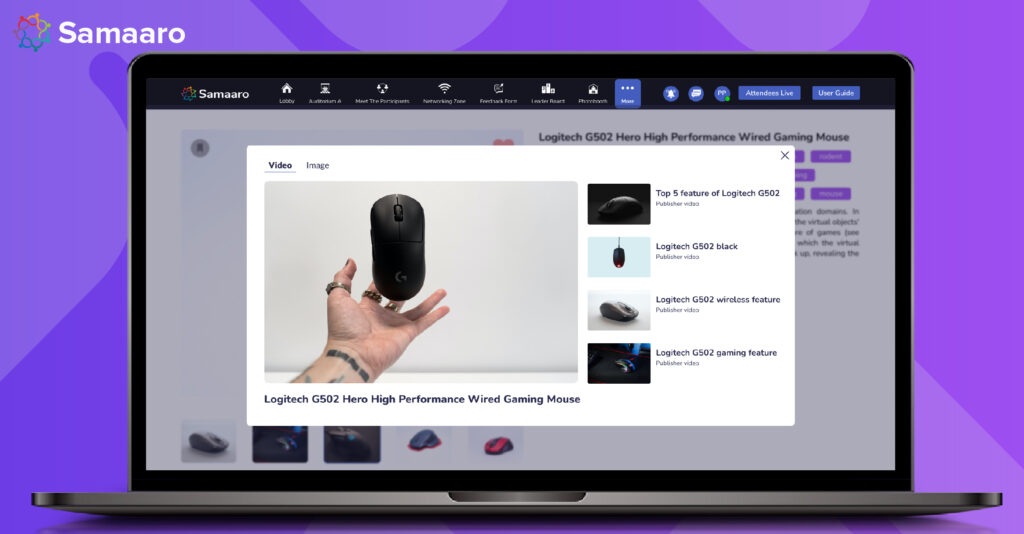
When it comes to showcasing products in a virtual exhibition, it’s essential to choose the right approach that fits your business needs and objectives. There are different types of products showcases that businesses can consider, depending on the nature of their products and the desired level of interactivity.
In Virtual Exhibition, there are various approaches to showcase products effectively. Some of the most common types include:
Here are some factors to consider when choosing the right showcase approach for your products in a virtual exhibition:
By considering factors such as the type of product, target audience, budget, technical requirements, brand image, level of interactivity, and compatibility with the virtual exhibition platform, you can choose the showcase approach that best highlights your products and resonates with potential customers.
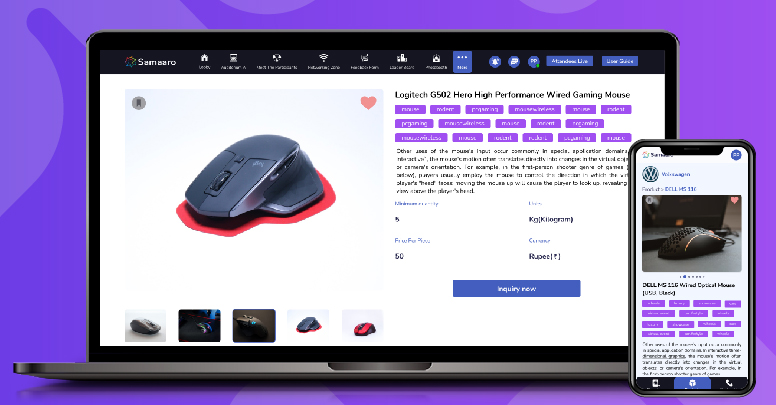
In today’s digital age, creating an immersive product showcase has become an essential component of successful marketing strategies. To achieve this, businesses must focus on designing an attractive and user-friendly virtual booth that incorporates interactive features and gamification to engage visitors.
When designing a virtual booth, it’s crucial to ensure that it is visually appealing and easy to navigate and displays your brand. The following are some ways of achieving this:
Utilizing interactive features is another way to make your product showcase more engaging. Here are some ways to do this:
(Note: Features like 3D walkthrough and Virtual Walkthrough can be implemented in property exhibitions to enhance the overall experience of the attendees)
Gamification is another way to engage visitors and make your product showcase more memorable. Some gamification ideas include:
Incorporating social features is another way to encourage visitors to engage with your virtual booth. Some examples include:
By designing an attractive and user-friendly virtual booth, incorporating interactive features and gamification, and incorporating social features, businesses can engage visitors and increase brand awareness and is vital component of modern marketing strategy.
Even if it is a virtual exhibition, businesses should not forget about the little but extremely important detail – i.e., human touch. Personal interaction is crucial for creating a positive customer experience, and it’s essential for businesses to find ways to add a human touch to virtual product showcases.
Virtual Exhibition offer businesses and organizations a unique opportunity to showcase their products and services to a global audience, without the limitations of physical space. Product showcasing is critical to engage potential customers and drive sales. Samaaro, an event technology platform, provides all the necessary tools and integration for an excellent product showcasing experience in Virtual Exhibition. By using high-quality images, videos, and 3D models, and virtual event technology, businesses can create an immersive and interactive experience that leaves a lasting impression on customers. Choosing the right product showcase approach is crucial, and factors such as the type of product, target audience, budget, technical requirements, brand image, level of interactivity, and compatibility with the virtual exhibition platform should be considered. With the increasing popularity of Virtual Exhibition, businesses and organizations need to adopt innovative ways to showcase their products and services, and Samaaro can help achieve this. So, start using Samaaro to showcase your products effectively and stand out in the virtual exhibition space.
The best way to streamline the time-consuming registration and queue procedures outside event locations is by considering an all-in-one event ticketing solution to assist event registrations. Curious about the operational mechanics? It’s simple: the event technology platform reduces the burden of event planners and commercial entities while also providing attendees with a seamless and painless experience. Before we get into the practicalities of event ticketing, let’s first understand it.
When you go to a trade show, conference, or event, the main aim is to get people to meet, make new connections, and share ideas. This is done by giving out tickets or badges to people who register and provide their information. These tickets let them into the event.
Typical features of this type of system include online ticket sales, attendee check-in, payment processing, and reporting/analytics capabilities. Organisers may streamline their operations, improve the attendance experience, and raise the success of their events by utilising an event ticketing and registration solution.
As for an in-person event, an event landing page is initially built to generate hype and assist with registration. This method allows guests to pre-register for the event, with their information stored on the website. We, at Samaaro, understand how each event is unique and work closely with the clients to build custom landing page for each event.
The ticketing alternatives for an event differ depending on whether it is free or paid. Scan a QR code upon admittance to the event to track attendee presence and outreach. Using an optimum event registration platform, along with its associated event registration and ticketing solutions, avoids the difficulties of long wait periods and queues, as well as the possibility of technical and informational complications.
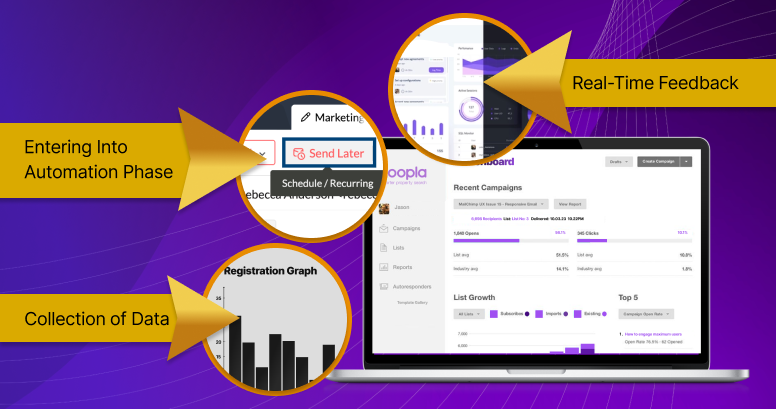
Event technology platforms provide a seamless experience, attendees can easily register for events, purchase tickets, and access event information anytime, anywhere, from any device. Attendees can enter their information, choose ticket types, and make secure online payments with a few clicks, increasing ease and accessibility. Guests can be given personalised registration forms that collect useful data, delivering a personalised experience from the start. For example, a color-coded ticket system could be used to distinguish between vegetarians (green ticket) and non-vegetarians (red ticket). Similarly, a silver pass may just allow admission to the exhibition and conference spaces, whereas a gold pass may allow access to all areas, including networking possibilities.
With the advent of event registration and ticketing systems, businesses and event organizers no longer need to collect data manually prone to human errors. With the help of event registration software, all event-related information can now be compiled in a single area that is easy to navigate. This includes information about registrations, attendance, number of check-ins, check-outs and time spend in the event, and areas navigated by the attendees.
Event registration platforms provide event organizers with expanded marketing capabilities such as targeted email campaigns, social media promotion, personalized landing pages, and analytics and reporting. These methods aid in raising event awareness, engaging participants, and driving attendance. Organizers can create a personalized and successful event experience by utilizing these elements.
Event registration and ticketing can significantly minimise the time and effort required to operate an event by removing the need for manual registration entry, bill and receipt printing, and phone or email communication. You may save time and money by utilising the power of an online solution instead of printing registration forms and event materials. Businesses can optimise resource allocation, eliminate human error, and reach higher productivity levels by substituting manual labour with automated operations.

In conclusion, online registration and ticketing systems provide various benefits to event organizers, such as convenience, increased attendance, increased revenue, streamlined check-in, and enhanced marketing capabilities. Businesses and event organizers can produce more effective events that are easier to execute and more profitable by utilizing these solutions.
If you’re planning an event, consider using an online event registration and ticketing solution for your in-person, hybrid, or virtual events to help it succeed – Samaaro is an all-in-one event technology, user-friendly, and resilient platform that offers a variety of event registration and ticketing options, making it suitable for events of all sizes. The dependability and security features of the platform ensure that your event runs well, decreasing the potential of technical issues or security breaches. You can be confident that your event registration and ticketing needs will be addressed to the highest standards when you use Samaaro.
In-person events have always been a great way to connect with like-minded individuals, network, and build business relationships. However, as technology continues to evolve, event planners are finding new ways to enhance the attendee experience using event technology. In this article, we will explore the benefits of event technology for in-person events, the types of event technology to consider, and the role of data in optimizing events. We will also discuss important factors to consider when choosing event technology, expert tips for implementation, and the future of event technology.
From streamlining event planning to enhancing the attendee experience, event technology offers a multitude of benefits. Here are some of the benefits of using event technology for in-person events:
There are many different types of event technology to consider for in-person events. These include:
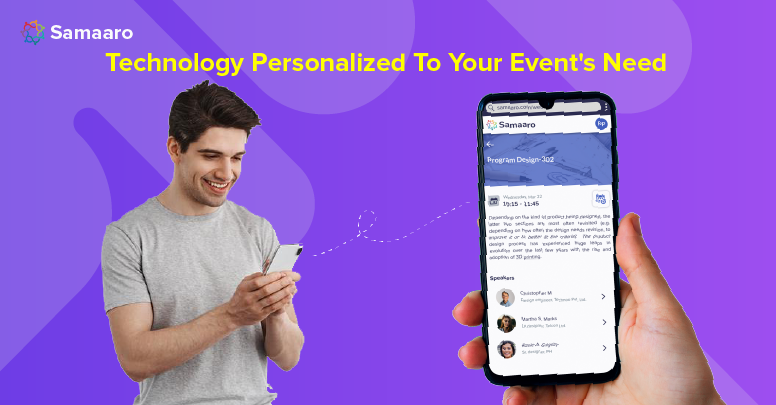
One of the primary benefits of event technology is its ability to improve attendee engagement. By providing interactive features, personalized content, and real-time engagement, event technology can create a more immersive and enjoyable event experience.
Ways in which event technology improves attendee engagement:
Data is a crucial component of event optimization. By collecting and analyzing data on attendee behavior, preferences, and engagement, event planners can identify areas for improvement and make data-driven decisions about future events.
Below listed are some points that lay out the role of Data in Optimizing In-Person Events
By leveraging data to optimize in-person events, event planners can make informed decisions, provide personalized experiences, and ultimately create more successful events.

By carefully considering these factors when selecting event technology, event planners can ensure that they choose the right software to meet their specific needs and help optimize their in-person events.
To ensure successful implementation of event technology at your next event, consider the following expert tips:
Event technology is constantly evolving, and its potential impact on in-person events is immense. Some researched and predicted potential future developments in event technology can include:
In conclusion, event technology has revolutionized the way in-person events are planned and executed. By incorporating technology into your events, such as Samaaro’s all-in-one event technology platform, you can increase attendee engagement, streamline planning processes, and generate valuable data to optimize future events. Samaaro offers features like registration, live streaming, virtual networking, and audience engagement tools that can help you create a seamless and engaging event experience for your attendees. Additionally, its user-friendly interface and excellent customer support make it easy to use and ensure a successful event. When choosing event technology, consider your goals, audience, and important factors such as cost and compatibility. With the continued evolution of event technology, the possibilities for enhancing in-person events with platform like Samaaro are endless.
Welcome to the exciting world of virtual trade exhibits! Virtual trade shows, like traditional trade shows, provide exhibitors with a unique opportunity to promote their brand and engage with potential clients. Exhibitors can receive access to a larger audience and leverage several unique features that improve lead generation when participating in the event. In a digital environment, attendees may connect with exhibitors and sponsors, and build prominent connections. There is no question that trade shows are most effective when attended in person, but going virtual can help you reach a wider audience, increase event visibility, meet interested attendees by setting up meetings in advance, assist booth staff in scheduling the right virtual meetings, and collect more leads through attendee engagement data that is automatically collected based on their activity.
Using virtual event platforms would provide event organizers with cutting-edge tools and features for a dynamic virtual trade show. In terms of important characteristics, a virtual event platform can simplify the integration of various components, such as virtual booths, to improve the overall experience of virtual trade shows, appointment scheduling, lead tracking, and various sponsorship levels. In this blog, we’ll discuss 5 features that can be incorporated into a virtual trade show.
Networking remains a core element of any virtual trade show and matchmaking is one feature that allows attendees to interact with exhibitors and vice versa. This function is typically based on an algorithm that matches participants’ interests with the offerings of exhibitors.
Virtual trade show platforms offer registration forms that let guests outline their interests so that the platform can match them with relevant exhibitors. By enabling connections between them, this innovation streamlines the event experience for both attendees and exhibitors.
A powerful matchmaking mechanism that allows guests to easily identify exhibitors who match their interests and needs is vital.
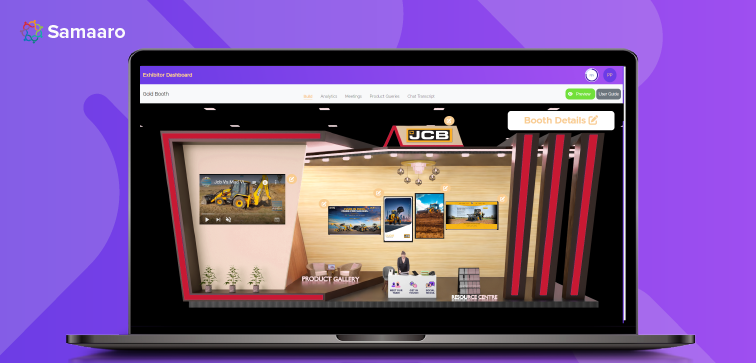
DIY booths can help exhibitors showcase their products and services in a better and more engaging way for a more personalized touch. With their logo and custom themes, exhibitors may personalize their booths and give visitors a distinctive experience that aids in setting them apart. They can use graphics, product demonstrations, product demo videos, and other interactive components to encourage audience interaction. This enables them to customize their booth for their target market and offer attendees a more distinctive experience.
Advanced lead generation features such as chats, “enquire now”, “schedule meeting”, bookmarking & wish listing can be incorporated into virtual booths for lead generation. These solutions can assist exhibitors in obtaining crucial information about guests, such as their contact details, interests, and purchasing patterns. Exhibitors can utilize this data to better target and personalize follow-up messages, which will increase the likelihood that leads will become clients.
Discover solutions offers advanced filters and search options that enable visitors to quickly and easily find the products or sellers that are most relevant to their needs. It allows users to do keyword or phrase searches for specific products or services.
Additionally, they may use a variety of filters to narrow down their search results, including product category, price range, location, and more. Visitors no longer have to filter through extraneous material to get what they’re searching for. Discover Solutions provides a wealth of information and resources to help them make informed decisions.
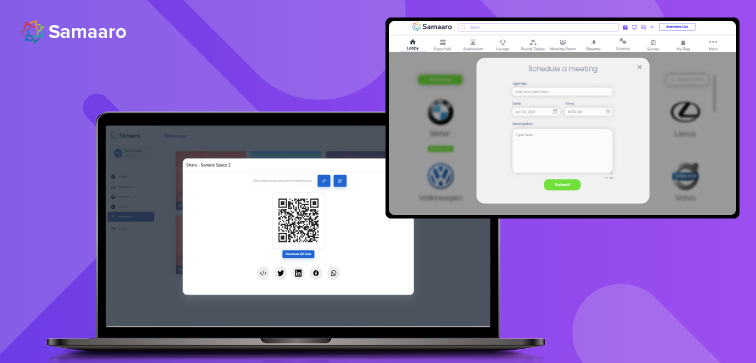
The meeting calendar tool allows visitors to set up meetings with exhibitors and vice versa. Once attendees understand the offerings of an exhibitor, the tool allows them to schedule appointments with these exhibitors and learn more about their products and services. It also allows exhibitors to create virtual booths and ask attendees to set up a meeting time. Attendees can manage their time better and not miss essential sessions by using a meeting scheduler. The event may be made more effective overall by using a meeting scheduler to personalize the experience for participants and encourage an interested and active audience.
Advanced analytics is a tool that allows organisers to track the behaviour and participation of attendees. These tools provide information on participant demographics, booth traffic, popular sessions, and other important indicators.
Using advanced analytics, organisers may better understand the interests and preferences of attendees and optimise their marketing efforts appropriately. They can also utilise this functionality to monitor the event’s progress and make data-driven decisions for future events. Certain reports like time spend and user activities can assist exhibitors in identifying the most promising leads and prioritising their efforts accordingly. Additionally, you can allow exhibitors to integrate various CRMs to their booths to easily manage these leads and follow up with them.
Virtual trade shows offer many benefits, including the ability to reach a wider audience and reduce costs associated with in-person events. Samaaro with its unique set of features can help virtual trade shows be more successful and engaging for both attendees and organizers. So, what are you waiting for? Go Samaaro!
In the age of social distancing, virtual events have become the new norm, and they’re not just a passing fad. These digital gatherings offer businesses a chance to go beyond the limits of brick-and-mortar venues and connect with audiences from all over the world. With the rise of cutting-edge technology, virtual events have become more engaging and interactive than ever before. So, if you’re looking for a way to spice up your relationship with customers and spice up your events, consider giving the virtual world a try!
In this article, we’ll provide a complete guide to virtual events, using Samaaro’s virtual event platform as an example, covering everything from choosing the right platform to marketing your event, and how technology can enhance the virtual event experience.
A virtual event is a type of event where attendees participate and experience the event and its content through online means instead of being physically present at a physical location. It involves the use of technology such as live streaming, video conferencing, and other web-based tools to facilitate engagement between participants and speakers. Virtual events can include webinars, online conferences, digital trade shows, and other similar activities that are conducted in a virtual environment. They are becoming increasingly popular because of the convenience they offer and the growing trend towards remote work and distributed teams.

Virtual events can complement and expand your overall event program, which includes events you organize, attend, and internal company events. It’s worth noting that virtual events are not intended to replace other types of events but rather to offer a new dimension to your overall program. Below are the 7 kinds of virtual events and some important points about these events.
Webinars
Virtual Conferences
Internal Hybrid Events
External Hybrid Events
Virtual Exhibitions
Virtual Seminars
Virtual Trade Shows
In today’s fast-paced and ever-changing world, hosting virtual events has become increasingly popular due to the convenience and accessibility they offer. Virtual events can provide a way to connect with a global audience, reduce costs, and offer flexibility for attendees to participate from anywhere. Below are some of the key reasons why hosting a virtual event may be a smart decision for your organization.

Planning a virtual event can seem daunting, but the process is quite like planning an in-person event. As with any event, it is important to put yourself in the attendees’ shoes and consider their experience. You don’t want to bore them with long stretches of content or neglect their need for engagement and interaction. By following standard planning tips and tricks, you can create and execute a successful virtual event.
Define Your Objectives
The first step in event planning is to define the purpose and goals of the event. Event planners need to identify the target audience, the type of event, and the objectives that need to be achieved using technology. For example, if the event is a conference, the objectives may include providing attendees with access to high-quality presentations, networking opportunities, and the ability to interact with the speakers and other attendees.
Here are some questions you should be asking before planning any virtual event.
Defining your objectives will help you make informed decisions throughout the planning process.
Choose the Right Platform
The most crucial step in hosting a successful virtual event is choosing the right platform. Samaaro’s virtual event platform offers a wide range of features and customization options to make your event stand out. Some of the features include:
Consider factors such as the number of attendees, your budget, and the type of event you’re hosting when choosing a platform.
Set a Date and Time
Once you’ve chosen your platform, it’s time to set a date and time for your event. Consider your target audience’s availability and choose a time that is convenient for them. Avoid scheduling your event during holidays or peak business hours.
Create an Agenda
Creating a clear and concise agenda for your virtual event is crucial. This will help you stay organized and ensure that your event runs smoothly. It will also help your attendees know what to expect from the event. Samaaro’s virtual event platform allows you to create a customized agenda for your event, including details such as the event’s start and end time, speakers, topics, and any interactive elements such as polls or Q&A sessions.
Choose Your Speakers
The success of your virtual event largely depends on the quality of your speakers. Choose speakers who are knowledgeable and engaging and who can offer valuable insights to your attendees. Samaaro’s virtual event platform allows you to invite and manage speakers for your event, making it easy to collaborate and ensure that your event’s content is top-notch.
Promote Your Event
Promoting your virtual event is crucial to ensure that you get the attendance you need. Use social media platforms, email marketing, and your website to promote your event to your target audience. Samaaro’s virtual event platform offers marketing tools like customizable email invites, registration pages, and social media sharing options to help you get the word out about your event.
Engage Your Audience
Engaging your audience during your virtual event is crucial to keep them interested and invested in your content. Use interactive elements such as polls, Q&A sessions, and breakout rooms to keep your attendees engaged and encourage participation. Samaaro’s virtual event platform offers a variety of interactive tools to keep your attendees engaged and ensure that your event is a success.
Follow Up with Attendees
Following up with attendees after your virtual event is crucial to maintain their interest and build lasting relationships. Send a thank-you email or survey to your attendees, asking for feedback and offering additional resources or information. Samaaro’s virtual event platform offers a post-event survey feature that allows you to gather feedback and insights from your attendees, helping you improve your future events.

To host successful virtual events, relying solely on video conferencing tools isn’t enough. A comprehensive event technology platform is essential for promoting, executing, and managing virtual events. Several important pieces of event tech are critical to utilize when hosting virtual events.
In conclusion, virtual events have become increasingly popular due to the convenience, accessibility, and flexibility they offer. They provide a way to connect with a global audience, reduce costs, and offer valuable data and analytics on attendee engagement and behavior. Hosting a successful virtual event requires careful planning and execution, and the use of the right technology. By following the tips and tricks provided in this guide, including choosing the right platform, marketing your event, and enhancing the virtual experience with technology, you can create a successful virtual event that engages your audience and meets your organization’s objectives. So, if you’re looking for a way to spice up your events and relationship with customers, consider giving the virtual world a try!
Samaaro’s virtual event platform offers a wide range of features and customization options to make your virtual event stand out. With its interactive elements, custom branding options, and detailed analytics, Samaaro’s platform can help you engage your audience, create a memorable experience, and build lasting relationships with your customers.
As virtual events continue to grow in popularity, businesses need to embrace the latest technologies and platforms to stay ahead of the curve. By following the tips outlined in this guide and leveraging the power of Samaaro’s virtual event platform, you can host a successful virtual event that drives engagement, builds brand awareness, and delivers value to your attendees.
Q: What is a virtual event?
A: It is a type of event where attendees participate and experience the event and its content through online means instead of being physically present at a physical location. It involves the use of technology such as live streaming, video conferencing, and other web-based tools to facilitate engagement between participants and speakers.
Q: What are the types of virtual events?
A: There are seven types namely webinars, virtual conferences, internal hybrid events, external hybrid events, virtual exhibitions, virtual seminars, and virtual trade shows.
Q: Why host a virtual event?
A: Because they offer several benefits such as accessibility, cost savings, flexibility, data and analytics, and sustainability. They can provide a way to connect with a global audience, reduce costs, and offer flexibility for attendees to participate from anywhere.
Q: How do you plan a virtual event?
A: Planning a virtual event is similar to planning an in-person event. It is important to define the objectives, choose the right platform, plan the content and schedule, promote the event, engage attendees, and measure success. The key is to use event technology to support the objectives of the event and enhance attendee experience.
Q: What is the virtual event technology checklist?
A: The virtual event technology checklist includes choosing the right virtual event platform, audio and visual equipment, reliable internet connection, engagement tools, and backup plans. It is important to test the technology beforehand to ensure a smooth experience for attendees.

Built for modern marketing teams, Samaaro’s AI-powered event-tech platform helps you run events more efficiently, reduce manual work, engage attendees, capture qualified leads and gain real-time visibility into your events’ performance.


© 2025 — Samaaro. All Rights Reserved.